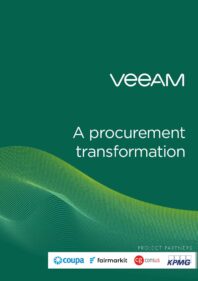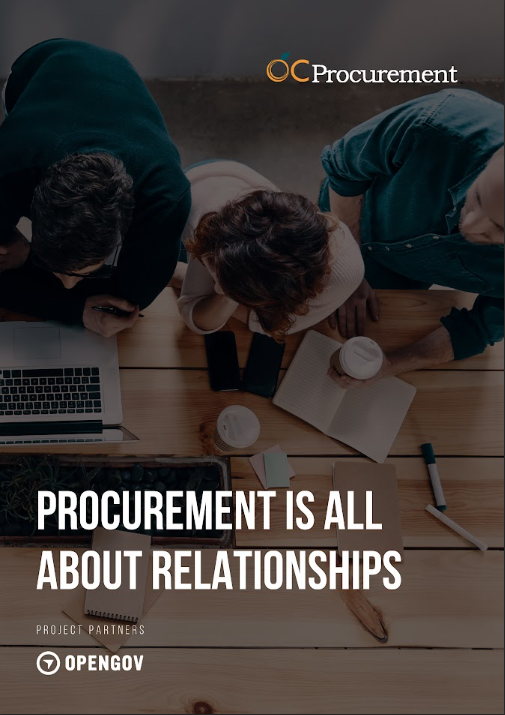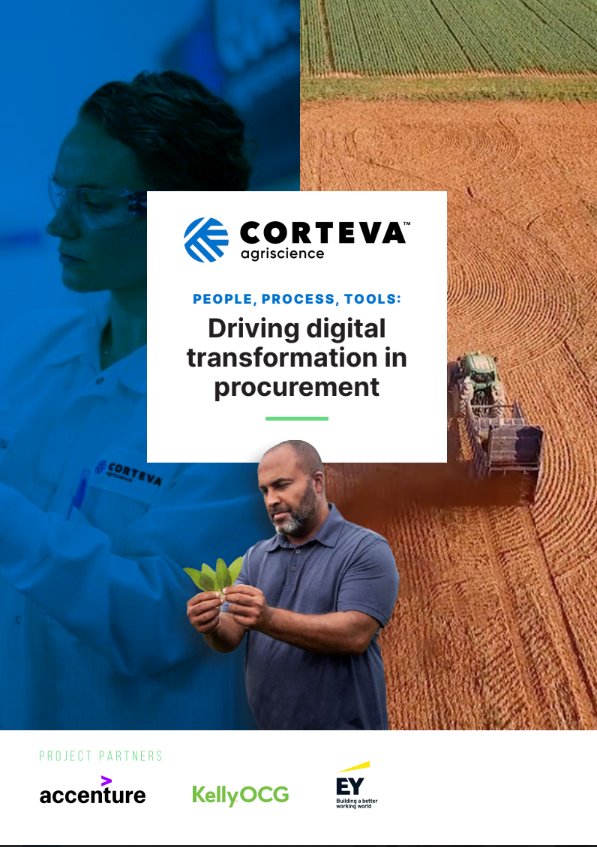CPOstrategy interviews Natalia Graves VP, Head of Procurement at Veeam Software to discuss the company’s procurement transformation
Natalia Graves is the first Vice President of Procurement at Veeam Software and when she joined in January 2018, she was asked to further evaluate already existing best practices at the software company, broadening those practices across the organisation, as well as introducing new ones “where it made sense”.
Veeam Software is a privately held information technology company and the leader in Cloud Data Management for organisations, ranging from SMB to enterprise. As Veeam Software grows so does its spend and Graves soon recognised the need to have a more systematic, pointed focus on procurement as a discipline. Graves was tasked with looking at the automating, simplifying, and accelerating of Veeam’s procurement and travel processes and systems around them, including evaluating and rolling out a company-wide source-to-pay platform. “It has been an incredible journey,” she tells us from her office in Boston, Massachusetts. “We looked at simplifying our processes and putting systems into place that allow Veeam teams across the globe to move even faster.”
Veeam had many stakeholders participating in the transformation: finance, technology teams, operations and business stakeholders (the largest spenders) all participated in the enterprise-wide RFP, going through the process to contribute, making sure Veeam picked the right company. “We’ve looked at all the leaders out there and through the process, selected Coupa as our Spend Management Platform and KPMG as our implementation partner,” she explains. “We looked to the likes of Gartner and Forrester, etc. to really understand what they are seeing happening in the industry, and who the leaders are, and how they evaluate them. We took that into our internal decision-making process and then selected what was right for Veeam.”
Veeam took the approach of going with industry best practice and changing the processes only when there was a true business case to do so. “We’ve done it through workshops that were enabled and conducted by our implementer – KPMG – and really, I think that spending the time to do that was what took the longest and was probably the most difficult stage. First and foremost, the most important step was really to observe what was happening, because people were extremely overloaded, and procurement was viewed as a black hole where things would enter only to come out months later. We absolutely had to look at automation.”
First, Graves looked at the operating model. “It was clear that we couldn’t sustain the volume of transactions that we had in the operating model that we had, so that had to be changed. We had manual processes and the end-to-end operating model and proper organisational structure had to be designed to effectively and efficiently support our fast-moving and demanding business stakeholders.”
The second part of the transformation was to identify the critical roles that were missing and had to be filled immediately. “We brought in a Director of Procurement Operations and a Director of Global Contracts that allowed us to move more freely, quickly, and begin to measure what needs to be done, and bring in the automation,” adds Graves. The third point of the transformation occurred once the process blocks were laid out on paper, as a part of an end-to-end, cradle-to-grave cycle.
“The candidates for automation and simplification just jumped out at you,” she says. “Existing processes were so painful and manual, and the teams were in such a large backlog, that transformation was inevitable. And so we went on a journey.” The procurement teams had been working out of mailboxes, and these were promptly removed before the team migrated to a centrally automated portal for the tracking of all the procurement activities. “We also, in parallel, with the help from IT and the CIO, launched a new procurement portal on the corporate Veeam intranet, that all Veeam employees could then access,” says Graves.
Another area for concern lay in the processing of contracts, as Veeam was 100% manual. “In a company of our size and complexity it became simply unsustainable, we outgrew our manual processes and so we launched the electronic signature initiative. We saw a stunning 72% improvement in obtaining digital vendor agreement approvals and signatures by implementing DocuSign. Just think about that for a moment. We’ve then taken it even further. As 100% of our contracts get adopted from a procurement side, we’re now starting to move this to sales contracts as well, so that’s a huge enabler.”
SECOND PHASE
With the “low hanging fruit and no brainers” taken care of in the initial phase of the transformation, Veeam turned its focus to a bigger transformation. “Where do we go from here and how do we clean up and prepare for the growth that is happening at Veeam?” asks Graves. “What tools do we need, what platforms do we require? The conclusion we came to is that the company needed to invest in a full source-to-pay system. As I’ve mentioned we’ve gone through an extensive RFP, with many future users’ and stakeholders’ organisations participating in the RFP, and eventually we landed on Coupa, our spend management platform of choice.”
Veeam required an easy and mobile experience aligned with the corporate strategy to enable employees to buy goods and service quickly, safely, mobile, and cost-effectively, while maintaining overall visibility and control. “Coupa was definitely best-of-breed on the P2P side and as we were going through the RFP it just clicked with us. We launched in December 2018 for Souring and CLM modules and then in January 2019 we launched by onboarding our pilot stakeholders’ groups.
Graves describes the digital transformation as a ‘three-way dance’. “We kept a close eye on the parties involved with KPMG acting as implementer for the source-to-pay solution. “We have gone through a thorough RFP selecting Coupa, but it’s not all about the platform, it’s all also about the implementer, who we also selected through a RFP process. We were also truly saved by Consus; another technology implementer who used their own AI tool to quickly clean up our large supplier database, suppliers and supply records in the ERP, saving months of manual work.” Transformations don’t happen overnight. Just because the system is launched, it does not mean the transformation journey is complete.
Saurabh Mehta, President and GM, Consus Global, explains, “Veeam needed to quickly clean, reduplicate and group their supplier master in order to meet tight project deadlines. Because Veeam’s procurement operations depended on it, we appreciated the high level of accuracy required from the output of this exercise. Using our AI engine we were able to deliver clean and highly reliable data to Veeam within 2 weeks.”
An automated system allows companies to perform some basic things, quicker and better, but more than that, there is less of human error so resources can be utilised on tasks that matter more, the strategic tasks. “Then your resources can better align with the business stakeholders, to make sure you listen and hear where each stakeholder is going, so you can design your commodity strategies, and your procurement strategies around that. A procurement understanding of the business strategy is absolutely key. You need to understand that strategy and incorporate it into your ways of procuring. You have a successful procurement organisation when you’re able to listen and translate what you’ve heard into sourcing and procurement strategies.”
And so what is Veeam’s procurement strategy? “What’s important to us is not only the price – price is very important – but we are also driven by the overall quality of what we buy, the overall value,” she says. “We don’t always buy the cheapest, but we do expect the best price for what we buy, that’s for sure. We want to invest the right time to negotiate that. Best value procurement is a concept that some companies use heavier than others, but I think the elements of it should be present in just about any organisation. In my opinion, the procurement organisation is only successful when it is guided by at least some element of best value, coming from understanding the current business needs, combined with the ability to predict what the future needs might be during said project implementation.”
Graves notes: “The first year our procurement evolution and transformation was focused on getting ourselves organised and setting the foundation”. Veeam procurement cleared the huge backlogs and put in the automation and undertook the sourcing and understanding of what its spend management needs looked like going forward. “Our transformation was possible because of our best-in-class people. While we didn’t always agree, teamwork across our large implementation teams representing the enterprise was a must. Together we selected a platform, found an implementer, partnered with them, launched the system, and embedded it into the company day-to-day. We’ve established some things from the category perspective, which didn’t exist before. We have category managers and specialists looking at each particular area, be it technology, be it marketing. This year is a year of completing the implementations, and further operationalising what we’re doing, as we turn into an improvement cycle of continuous improvement. While we have accomplished a lot, evolution and continuous improvement never stops. As we go down the road this year, we view best in class negotiation practices and agile procurement processes becoming more and more a part of Veeam DNA.”
Graves believes that oftentimes CPOs are still viewed as very transactionally focused and an internal administrative hurdle to overcome. “CPOs are sometimes viewed as someone whose organisation will only make sure contracts are done with the proper terms, someone who runs controls and enforces policy around the buy-in process and someone who only cares about saving or cost. However, I think these so-called ‘administrative musts’ are just the foundation to the services the CPOs must offer to their companies. The role of a modern CPO implies taking the time to understand the business, and only then, design and run the best possible practices relevant to that particular company. The role of a CPO is the role of a business partner who designs a procurement organisation that supports business priorities and needs, and that can adapt to the ever-changing landscape.”









